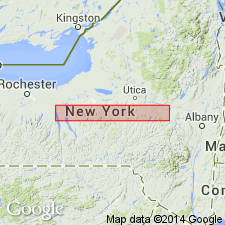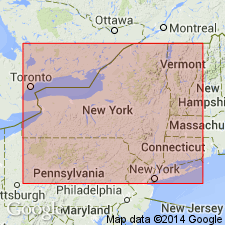
- Usage in publication:
-
- Edgecliff member
- Modifications:
-
- Named
- Dominant lithology:
-
- Limestone
- AAPG geologic province:
-
- Appalachian basin
Summary:
Edgecliff named as lowest member of Onondaga Limestone. Composed of massive light-gray, or sometimes pink, very coarsely crystalline limestone characterized, in type area of Onondaga, by profusion of tabulates, large rugose corals, and crinoidal columnals. This is true coral biostrome and is Hall's (1879, NY G.S., Paleontology, v. 5, pt. 2) "great coral bearing limestone" and the "Onondaga limestone" of early reports. Biostrome ranges in thickness from 8 ft at Split Rock to 25 ft at Chittenango Falls. Base of this unit is very sandy in most places. Sandy zone, referred to as Springvale horizon, ranges in thickness from a fraction of an inch with only widely scattered sand grains to 4 ft of sandstone. Carries Onondaga fauna and is easily distinguished from true Oriskany sandstone. Whitish-gray chert nodules are characteristic of upper half of limestone but may also occur in lower part. Member can be traced as far west as Buffalo; main changes are in thickness and amount of chert. Near Buffalo contains large biohermal "reef" structure 35 ft thick and several hundred ft in diameter. Thickens eastward. 20 ft thick at Springfield Four Corners, where biostrome extends to top of member; 39 ft in Berne and Albany quads, where biostrome occupies only lower 16 ft. Underlies Nedrow member (new). Onondaga in NY is generally considered lower Middle Devonian (Onesquethawan stage).
Source: GNU records (USGS DDS-6; Reston GNULEX).

- Usage in publication:
-
- Edgecliff Member
- Modifications:
-
- Revised
- AAPG geologic province:
-
- Appalachian basin
Summary:
Authors informally propose two dominant, widespread facies of the Edgecliff Member of the Onondaga Limestone: the cherty, micritic Clarence facies, formerly known as the Clarence Member of western NY, and a coarse crinoidal, non- to sparsely cherty Jamesville Quarry facies. The Jamesville Quarry is present at the Edgecliff type locality near Syracuse, where it reaches a thickness of about 5.7 m. To the west the Edgecliff thins to a minimum of 2.5 m at Seneca Stone quarry. The only trace of Clarence-like lithology at this location is a distinctive 0.5 m-thick band of cherty calcisiltite 1.8 m above the base of the Edgecliff. Between Seneca Stone quarry and Phelps the Edgecliff thickens and is composed primarily of sparsely fossiliferous calcisiltites with abundant bands of dark gray to black chert, closely resembling the typical western NY Clarence facies. Total thickness of the Edgecliff reaches a maximum of 14 m. Unit underlies calcareous shale-dominated strata and laterally equivalent argillaceous limestones of the Nedrow Member. The Foxtown Member of the Buttermilk Falls Limestone of eastern PA is directly equivalent to the Edgecliff. The basal contact is conformable in parts of eastern NY, but westward becomes unconformable and overlies increasingly older Devonian to Silurian strata. In some parts of west-central to western NY, overlies upper Lower Devonian Tristates Group and elsewhere the Middle Devonian Hamilton Group. This basal unconformity is known as the Wallbridge Unconformity. The Lower-Middle Devonian (Emsian-Eifelian) boundary, long placed at the base of the Onondaga in NY, could lie as high as the base of the Nedrow Member according to Kirchgasser and Oliver (1993), as there are no age diagnostic fossils in the Edgecliff.
Source: GNU records (USGS DDS-6; Reston GNULEX).
For more information, please contact Nancy Stamm, Geologic Names Committee Secretary.
Asterisk (*) indicates published by U.S. Geological Survey authors.
"No current usage" (†) implies that a name has been abandoned or has fallen into disuse. Former usage and, if known, replacement name given in parentheses ( ).
Slash (/) indicates name conflicts with nomenclatural guidelines (CSN, 1933; ACSN, 1961, 1970; NACSN, 1983, 2005, 2021). May be explained within brackets ([ ]).

